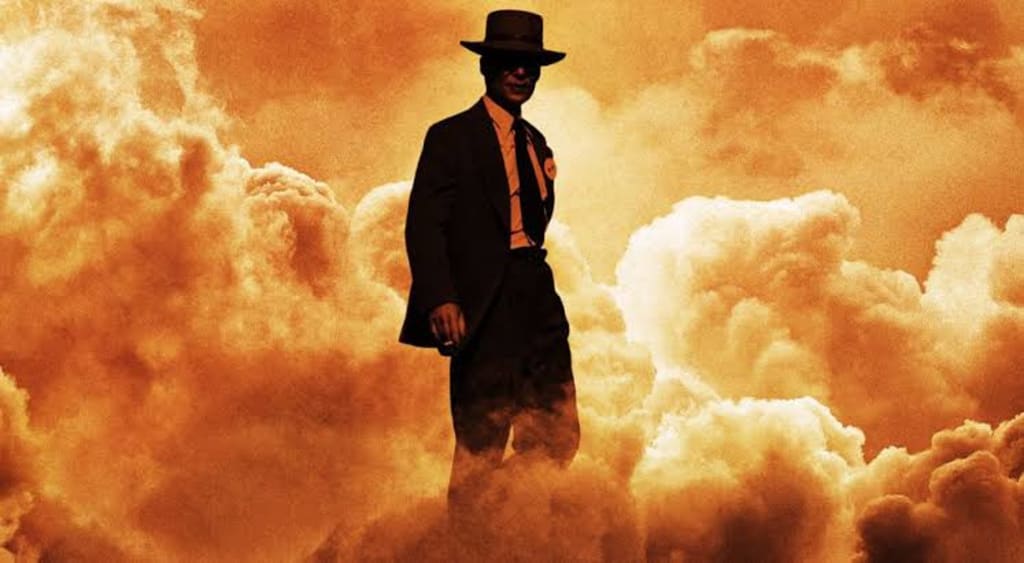
Oppenheimer
There is a moment in Oppenheimer when they’re finally ready to test the bomb that all these brilliant scientists in Los Alamos, New Mexico have been building for the past few years, when everything goes quiet. A stillness sets in as bright, searing light washes over everything.
The onlookers stare into this mad inferno slathered in sunscreen, protective goggles strapped to their faces. And then, suddenly, the shock wave. A terrible thunderclap. It is at once a force of nature, and utterly unnatural. As the climax to a film about the creation of the first atomic bomb, it’s perfect.
But it is not the climax. After Oppenheimer and his ragtag team of physicists, engineers, mathematicians and military officials successfully tests the bomb, we’re only two-thirds of the way through. The Third Act is only just beginning.
I’ve spent a lot of time mulling Christopher Nolan’s latest film over in my mind since seeing it yesterday, and I would be lying if I told you that my thoughts were entirely formed. How do I feel about this strange historical biopic? Do I feel anything at all?
I’m afraid the answer to that second question is . . . not really. This is a movie that made me think perhaps more than any other film I’ve seen this year, but I walked out of the theater last night and felt almost nothing at all.
It would be true to say that I found it riveting start to finish, even though it’s slow and often hard to follow. But it would also be true to say that Oppenheimer is much too long and its delivery far too muddled to be considered anything more than a visually provocative biopic that seems less interested in character study than it does in setting a mood. Christopher Nolan likes to play tricks with chronology in his films, often to great success, but here Nolan’s stylistic and narrative habits are too jarring. Too inconsistent. This is not Tenet. I don’t want to spend time puzzling out timelines.
For anyone not familiar with this particular history and its players, Oppenheimer is not just difficult to follow, but hard to care about. The big reveal—about two thirds of the way through the film—isn’t particularly shocking or compelling since the relationship between Straus (played with gusto by Robert Downey Jr.) and Oppenheimer (in a career-high for Cillian Murphy) is never well-established.
Had Nolan tried to develop this relationship earlier on in the film, the twists and turns it takes later on might have meant something. But this is a film that seems uninterested entirely in telling a human story, and too interested by half in being clever about it. There human moments, of course, here and there. Scenes scattered across the film’s three long hours where characters feel things or engage in some conflict with one another. But this collection of moments does not result in anything really resembling a coherent story.
The cast is massive, filled with even more stars and cameos than Wes Anderson’s Asteroid City, which was chock-full of A-listers in C-list roles. It’s hard enough to keep track of all these scientists and politicians and generals and wives and mistresses without Nolan’s ridiculous flash-forwards and flash-backs. (And while Asteroid City was also mostly a collection of moments, those moments at least made me feel something in the end).
Timelines are handled visually via the use of color and black-and-white film. We are anchored to before the Trinity tests and the end of WWII by color, and in the post-war era when it’s shot in black-and-white. But even here, Nolan breaks his own rules, leaving us unable to rely on desaturation to root us in events. It’s frustrating, mostly because the timeline-hopping feels unnecessary. Sure, most biopics are told chronologically, and I suppose there’s an argument to be made for why hopping around so much makes sense, but I’m not sure what that argument is.
Nolan’s use of loud, overbearingly tense music to create a sense of tension is unearned here, in this mostly quiet movie about scientists concocting the most terrible invention of all time. Sure, cataclysm approaches, but at times it feels as though sonic discord is simply filling in for actual narrative tension. It’s a strange dissonance. Thrumming, building, bass-laden instrumentals, a rising sense of dread and menace, all leading to a crescendo in . . . a small hearing room, where we see Oppenheimer railroaded by his own government after the war, suffering through a humiliating hearing over his security clearance, far from the public eye.
The problem is not the subject matter. The building of the bomb is compelling. The courtroom drama and the conflict that Oppenheimer faced after the war based on his opposition to a nuclear arms race is fascinating as well. So is his history of left-wing politics. It’s the delivery that leaves me a little cold, a little dizzy but not fun-dizzy. The twists that make a film like Interstellar so powerful simply don’t work in a true story quite as effectively. Or perhaps Nolan is just a little too predictable here.
Cillian Murphy is wonderful. His performance has Oscars written all over it, and rightfully so. He makes the movie far more watchable than it otherwise would have been. Robert Downey Jr. is at last free of Tony Stark and reminds us what a damn fine actor he truly is when he’s given good material to work with. There are many damn fine actors here, including Emily Blunt as Kitty, Oppenheimer’s alcoholic, long-suffering wife. I’d list more, but there are too many to count. Some, like Rami Malek as Dr. Hill, are little more than throwaway cameos until suddenly they have a very important part to play—in and of itself a jarring approach that made me think “Ah, I guess they decided to give Malek some lines” which isn’t something you want to be thinking at that point in a movie. And there is also such a thing as too many recognizable faces in a film, though perhaps that’s a discussion for another time. Regardless, the performances are immaculate all the way around, from Matt Damon to Gary Oldman and everyone in-between.
In the end, this is a film that seems to try very hard to be profound and powerful but cloaks so much of its story in camera tricks and loud, dialogue-burying music, that ultimately Nolan feels like his own worst enemy. His attention to detail is superb, of course, but one wonders if he even has the capacity to just play it straight from time to time, or if it’s all smoke and mirrors (fitting for the director of The Prestige).
The final scene is haunting and powerful. The bomb itself, its ferocious plumage, the blast of sound long moments after its blinding eruption, was almost enough of a reason to see the film all by itself. But there’s a hollowness to it all that I can’t quite shake. Maybe we’re supposed to feel empty after watching such a grim history unfold.
For Los Alamos history buffs and physicists, perhaps there is much to love here. I certainly did not hate this picture; I just wish that Nolan had taken a moment to make us care about these characters and their stories more, to help us understand the stakes, to get us to root for someone or even just against someone, rather than merely thrust us once again into his relentless pursuit of sound and fury.
“Oppenheimer,” a Warner Bros. film, captures a pivotal moment when brilliant scientists in Los Alamos, New Mexico, prepare to test the atomic bomb they’ve been building. As the bomb unleashes a blinding light and a thunderous shockwave, the movie’s climax seems perfect. However, the film continues beyond this point, delving into the aftermath of the successful test.
Reflecting on Christopher Nolan’s latest creation, the movie proves riveting despite its slow pace and occasional confusion. While visually striking, “Oppenheimer” suffers from being excessively long and lacking clear character development. The relationships between key figures, such as Oppenheimer and Straus, lack depth, making the big reveal less impactful.
The film features an extensive cast, with stars and cameos aplenty, but Nolan’s non-linear storytelling complicates matters unnecessarily. The use of color and black-and-white film to indicate timelines further adds to the confusion. Nolan’s signature tense music, while effective in other films, doesn’t always fit well with the more subdued tone of scientists working on the bomb.
Though the subject matter itself is compelling, including the building of the bomb, Oppenheimer’s post-war conflict, and his history of left-wing politics, the movie’s execution leaves something to be desired. The twists that work so well in fictional films like “Interstellar” may not resonate as powerfully in a historical biopic. Cillian Murphy’s stellar performance stands out, as does Robert Downey Jr.’s portrayal of Straus.
Ultimately, Nolan’s attention to detail and impressive visuals come at the cost of establishing a stronger emotional connection with the characters and their stories. The final scene’s haunting power leaves a lingering emptiness, making one wonder if we are meant to feel this way after witnessing such a grim history unfold.
While “Oppenheimer” may appeal to history enthusiasts and physicists, it leaves some viewers wishing for more emotional depth and coherence. Nolan’s pursuit of spectacle sometimes overshadows the human element, preventing the film from reaching its full potential.“Oppenheimer,” a Warner Bros. film, captures a pivotal moment when brilliant scientists in Los Alamos, New Mexico, prepare to test the atomic bomb they’ve been building. As the bomb unleashes a blinding light and a thunderous shockwave, the movie’s climax seems perfect. However, the film continues beyond this point, delving into the aftermath of the successful test.
Reflecting on Christopher Nolan’s latest creation, the movie proves riveting despite its slow pace and occasional confusion. While visually striking, “Oppenheimer” suffers from being excessively long and lacking clear character development. The relationships between key figures, such as Oppenheimer and Straus, lack depth, making the big reveal less impactful.
The film features an extensive cast, with stars and cameos aplenty, but Nolan’s non-linear storytelling complicates matters unnecessarily. The use of color and black-and-white film to indicate timelines further adds to the confusion. Nolan’s signature tense music, while effective in other films, doesn’t always fit well with the more subdued tone of scientists working on the bomb.
Though the subject matter itself is compelling, including the building of the bomb, Oppenheimer’s post-war conflict, and his history of left-wing politics, the movie’s execution leaves something to be desired. The twists that work so well in fictional films like “Interstellar” may not resonate as powerfully in a historical biopic. Cillian Murphy’s stellar performance stands out, as does Robert Downey Jr.’s portrayal of Straus.
Ultimately, Nolan’s attention to detail and impressive visuals come at the cost of establishing a stronger emotional connection with the characters and their stories. The final scene’s haunting power leaves a lingering emptiness, making one wonder if we are meant to feel this way after witnessing such a grim history unfold.
While “Oppenheimer” may appeal to history enthusiasts and physicists, it leaves some viewers wishing for more emotional depth and coherence. Nolan’s pursuit of spectacle sometimes overshadows the human element, preventing the film from reaching its full potential.





Comments
There are no comments for this story
Be the first to respond and start the conversation.